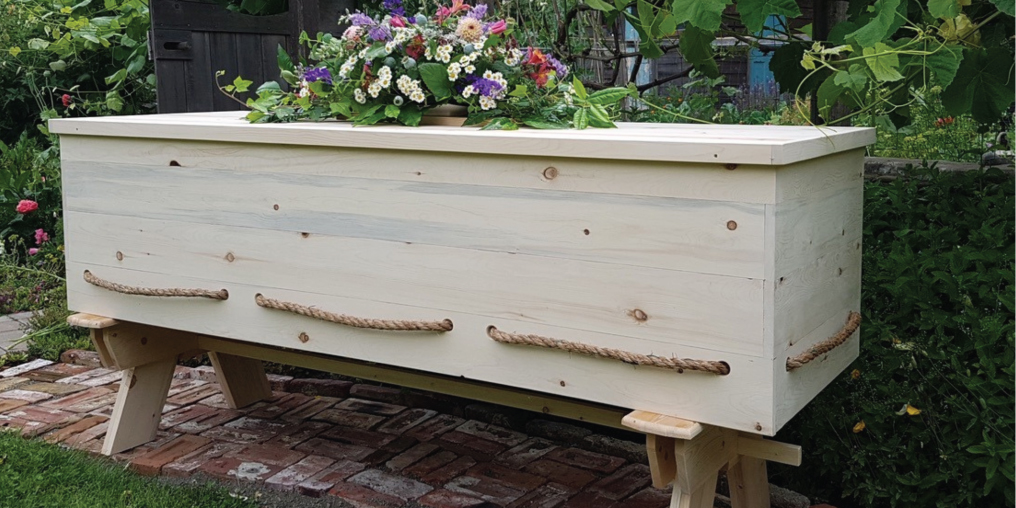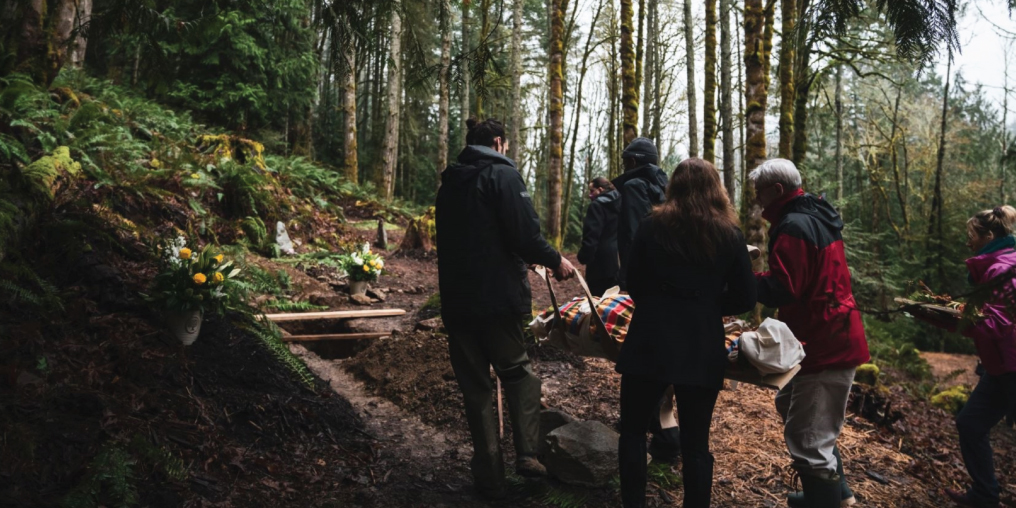It’s better to burn out than to fade away? Not always. New alternatives to cremation allow bodies to return to the earth naturally.
Have you considered how your death will impact the planet?
We live in a busy, death-phobic culture. Many of us haven’t stopped to ponder our end-of-life footprint. But the fact is, no one gets out of here alive, so let’s talk about death. If you, or someone you care about, are committed to living sustainably, a green, or natural, burial might be the way to go. Pun intended.
WHAT DO WE CURRENTLY DO?
When someone dies, the two best-known ways to dispose of the body are burial and cremation.
Conventional funerals and burials put formaldehyde-based embalming fluid, steel, concrete, and rare tropical hardwood into the earth.
In Canada, cremation is a common choice, but it’s still problematic from an environmental perspective. Because equipment needs to run at extremely high temperatures, the process uses large amounts of fossil fuel. And with no nationwide standard for emissions controls related to cremation—only best-practice and specific requirements set at regional and local levels—this method allows for the release of greenhouse gases like carbon dioxide and nitrogen oxide, as well as mercury and other heavy metals.
Still, Canadian cremation rates have risen from 48 per cent in 2000 to 73 per cent in 2020; this rate is forecasted to grow to almost 78 per cent by 2024. British Columbia (BC) has the highest cremation rate in Canada, at around 80 per cent.
Given that these two popular disposition methods release a lot of pollution into the earth and atmosphere, it’s time to start thinking outside of the coffin.
WHAT IS GREEN BURIAL?
A green, or natural, burial is one of the lowest-impact disposition options. It simply means that everything entering the ground is non-toxic and biodegradable, so decomposition can occur and the body can return to the earth naturally. There’s no embalming, and the body is wrapped or placed in a natural, biodegradable casket or fibres. (Ideally, these materials are sourced locally to keep the carbon footprint low.) The body is then buried three to four feet deep to allow microbial activity—basically, it’s similar to composting.
Natural burial cemeteries are designed to optimize the land, with minimal infrastructure, natural headstones, and/or communal memorials. Indigenous plants are often placed on the graves to help establish the ecosystem and allow for restoration and conservation of the land.
Family and community participation in such burials, and even home funerals (a passion of mine), can be very cathartic and aid in the grieving process.
LOCAL RESOURCES
Here in the Comox Valley, we have our very own casket and shroud makers! Sita and Gavin Then of Evergreen Coffin Company in Royston craft caskets from BC pine and spruce, and shrouds made of natural, unbleached cotton and jute webbing handles. You choose between ordering a fully built casket or putting it together yourself.
Sita says, “A homemade coffin becomes a central piece that mourners can gather around, creating a sense of community and a way to process grief.”
WHEN DID GREEN BURIAL START?
While green burial is an alternative to conventional Western burial methods and funerary customs, it’s an ancient practice. Many cultures and religions (whether Indigenous, Islamic, Jewish, or Christian) care for the body at home and practice natural burial.
So, while it’s not new, it’s gaining attention as part of the global movement of connecting to nature and giving back to the earth in sustainable ways.

WHERE CAN I HAVE A GREEN BURIAL?
Unfortunately, there aren’t many places to have a natural burial locally. Yet.
Courtenay Civic Cemetery doesn’t currently allow it, but if you’d like to be buried naturally there, call and make a request. The higher demand they have, the sooner it’s likely to be a choice. The same holds true no matter where you live.
Cumberland Cemetery is a hybrid cemetery, with a natural burial area set aside in a conventional cemetery. There are several of these hybrids on Vancouver Island and surrounding areas, including Elk Falls Cemetery in Campbell River, Cranberry Cemetery in Powell River, Yates Cemetery in Parksville, and Royal Oak Burial Park in Victoria. There are many others throughout BC and Canada, with new ones being added to the list each year.
Denman Island Natural Burial Cemetery, which opened in 2015, is Canada’s first entirely natural burial ground. This cemetery is open to residents and landowners only, past or present, as well as their immediate family members. Lucky you if you have access to that!
Outside the Comox Valley Regional District—but close enough for a day trip—Salt Spring Island Natural Cemetery, opened in 2020, is the first natural cemetery in Canada open to the public.
WHAT IF A GREEN BURIAL ISN’T FOR YOU?
There are other green disposition alternatives gaining popularity. Natural organic reduction, also referred to as recomposition or terramation—essentially human composting—is one option.
Another is aquamation, or alkaline hydrolysis—a more eco-friendly alternative to flame-based cremation. In this process, the human body is reduced to its simplest elements by using an alkaline water mixture. Because it uses much less fuel, aquamation results in up to 90 per cent energy savings and a smaller carbon footprint when compared to flame cremation. Current legislation doesn’t allow for aquamation to take place in BC, although it’s an accepted form of disposition in three Canadian provinces, the Northwest Territories, and 21 US states.
Given BC’s high cremation rate, it makes sense that this should become an option for people. If you agree, head over to Change.org and sign the petition.
WHAT’S NEXT?
Talking with friends and family about natural burial, making your choices known, and petitioning for aquamation are ways that will help increase demand and provide end-of-life choices that align with people’s environmental values.
Community education and advocacy are key. They empower us to think about how we might give back to the earth in death, so future generations can enjoy meaningful life and end-of-life experiences.
For more information: Watch this YouTube video: A Beginner’s Guide to Green Burial & More
Sign the petition: Bring Aquamation to BC! at Change.org





